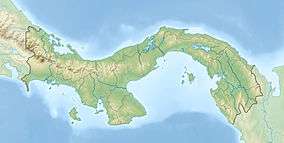Coiba
| Coiba National Park | |
|---|---|
|
IUCN category II (national park) | |
|
Isla Granito de Oro, Coiba National Park | |
 Location in Panama | |
| Location | Veraguas Province, Panama |
| Coordinates | 7°28′N 81°47′W / 7.467°N 81.783°WCoordinates: 7°28′N 81°47′W / 7.467°N 81.783°W |
| Area | 503 square kilometres (194 sq mi) |
| Established | 1992 |
| Official name | Coiba National Park and its Special Zone of Marine Protection |
| Type | Natural |
| Criteria | ix, x |
| Designated | 2005 (29th session) |
| Reference no. | 1138 |
| State Party | Panama |
| Region | Latin America and the Caribbean |
Coiba is the largest island in Central America, with an area of 503 km2 (194 sq mi), off the Pacific coast of the Panamanian province of Veraguas. It is part of the Montijo District of that province.
History
Coiba separated from continental Panama about 12,000 to 18,000 years ago when sea levels rose. Plants and animals on the new island became isolated from mainland populations and over the millennia most animals have diverged in appearance and behavior from their mainland counterparts. The island is home to many endemic subspecies, including the Coiba Island howler monkey, the Coiba agouti and the Coiba spinetail.
Coiba was home to the Coiba Cacique Indians until about 1560, when they were conquered by the Spanish and forced into slavery. In 1919 a penal colony was built on the island and during the years that Panama was under the dictatorships of Omar Torrijos and Manuel Noriega, the prison on Coiba was a feared place with a reputation for brutal conditions, extreme tortures, executions and political murder. Nobody knows exactly how many people were killed in the prison during this period, but sources claim that the number could be close to three hundred. As such, the island was avoided by locals, and other than the prison, was completely undeveloped.
After the prison was closed down in 2004, its pristine condition made it ideal as a reserve. It is now said that the prison is haunted by the ghosts of prisoners. One story is that a guard was chasing a prisoner, but the prisoner was a ghost. The guard was so scared that he shot himself. It is also one of the last places in Central America where the scarlet macaw can be found in large numbers in the wild. The island is about 75% forested with a large fraction standing as ancient forest. Coiba Island is home to rare plant species found only on the island. The island also harbors tree species that have long disappeared from the mainland due to deforestation and overharvesting.
The island was declared a national park in 1992 and in July 2005, Unesco declared the entire Coiba National Park a "World Heritage Site".
Environment
Coiba's underwater topography is linked by the underwater Coco Ridge mountain chain to the Galápagos Islands. Scientists from the Smithsonian Tropical Research Institute have proclaimed it an unparalleled destination for discovering new species. Rachel Collin, a Smithsonian project coordinator said: "It's hard to imagine, while snorkeling around a tropical island that's so close to the United States, that half the animals you see are unknown to science.”[1]
Its unique location protects it from the damaging winds and other effects of El Niño, allowing it to sustain the uninterrupted evolution of new marine species including whale and tiger sharks, sperm whales, sea turtles, angel rays and giant schools of fish. It is also the last refuge for a number of threatened terrestrial animals such as the crested eagle and several sub-species of agouti, possum and howler monkey (including a Coiba Island howler monkey).
The waters adjacent to the island are teeming with marine life. It is surrounded by one of the largest coral reefs on the Pacific coast of the Americas. The Indo-Pacific current through the Gulf of Chiriqui provides a unique dive environment. The warm current brings with it coral and many of the pacific tropical underwater life that you would not expect on the Pacific Coast of the Americas. Also with it come the larger fish/mammals such as humpback whales, sharks, whale sharks, orcas and more. Some 760 species of fish have been recorded here, including snappers, barracuda, amberjack, and three types of marlin. Due to all this marine life, the Coiba National Park is an excellent place to snorkel and scuba dive.
References
- ↑ "45 New Reasons to Conserve Panama's Coiba National Park". Smithsonian Tropical Research Institute. Retrieved 17 March 2011.
External links
| Wikimedia Commons has media related to Coiba National Park. |
![]() Coiba travel guide from Wikivoyage
Coiba travel guide from Wikivoyage